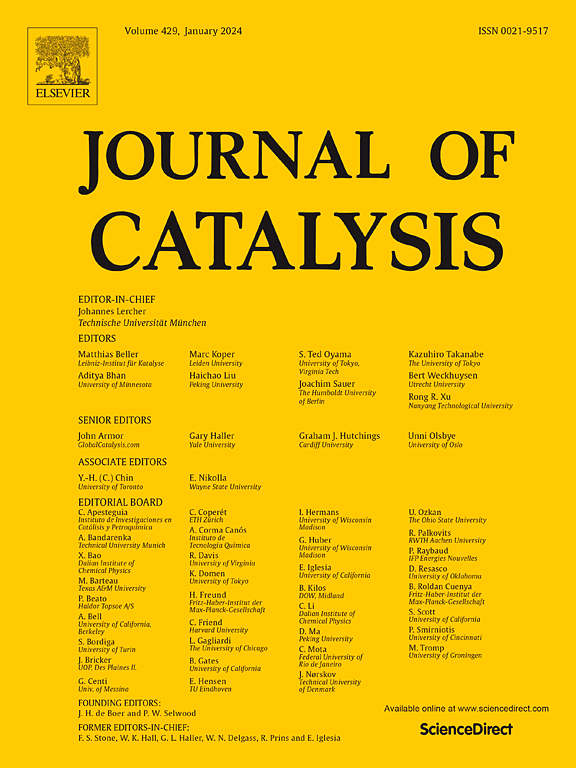揭示富氮共轭共价有机骨架上高选择性生成过氧化氢的催化机理
IF 6.5
1区 化学
Q2 CHEMISTRY, PHYSICAL
引用次数: 0
摘要
共价有机骨架(COFs)是一种具有可调节骨架和孔隙度的多孔材料。COF上的氧还原反应(ORR)可以生成H2O2。然而,目前还需要实验证据来证明其催化机理。本文采用水热法制备吡嗪类含氮COF (PN-COF)的结构模型,研究其H2O2的生成过程。由于水热环境显著地推动前驱体缩聚形成大的建筑单元,得到的PN-COF具有较高的电导率(2.47 × 10−3 S m−1)。因此,在PN-COF的催化下,H2O2的选择性转化率高达99% %。理论DFT计算、原位傅立叶变换红外光谱、原位拉曼和原位电子顺磁共振测量证实,PN-COF中的吡嗪分子发生了结构演化,导致活性位点的产生,并在PN-COF上生成1,4-内过氧化物(*OO*)。揭示了一步双电子途径的催化机理。这些结果为设计高选择性、高效率的非金属电催化剂提供了理论指导。本文章由计算机程序翻译,如有差异,请以英文原文为准。

Unveiling catalytic mechanism for highly selective production of hydrogen peroxide on nitrogen-rich conjugated covalent organic frameworks
Covalent organic frameworks (COFs) belong to porous materials with tunable skeletons and porosities. Oxygen reduction reaction (ORR) on COF can generate H2O2. However, experimental evidences for the catalytic mechanism are currently needed. In this work, a structure model of pyrazine nitrogen-containing COF (PN-COF) prepared by hydrothermal reaction is applied to study the H2O2 generation. Because hydrothermal environment significantly drives the polycondensation of precursors to form large building units, the obtained PN-COF shows high conductivity (2.47 × 10−3 S m−1). Thus, extremely high selective conversion of H2O2 production up to 99 % is achieved catalysed by PN-COF. Theoretical DFT calculations, and in situ Fourier-transform infrared spectra, in situ Raman and in situ electron paramagnetic resonance measurements confirm that the pyrazine molecule in PN-COF undergoes a structural evolution resulting in an active site and the generation of 1,4-endoperoxide species (*OO*) on PN-COF. The catalytic mechanism of one-step two-electron pathway is unveiled. These results provide theoretical guidance for design of highly selective and efficient non-metal electro catalysts.
求助全文
通过发布文献求助,成功后即可免费获取论文全文。
去求助
来源期刊

Journal of Catalysis
工程技术-工程:化工
CiteScore
12.30
自引率
5.50%
发文量
447
审稿时长
31 days
期刊介绍:
The Journal of Catalysis publishes scholarly articles on both heterogeneous and homogeneous catalysis, covering a wide range of chemical transformations. These include various types of catalysis, such as those mediated by photons, plasmons, and electrons. The focus of the studies is to understand the relationship between catalytic function and the underlying chemical properties of surfaces and metal complexes.
The articles in the journal offer innovative concepts and explore the synthesis and kinetics of inorganic solids and homogeneous complexes. Furthermore, they discuss spectroscopic techniques for characterizing catalysts, investigate the interaction of probes and reacting species with catalysts, and employ theoretical methods.
The research presented in the journal should have direct relevance to the field of catalytic processes, addressing either fundamental aspects or applications of catalysis.
 求助内容:
求助内容: 应助结果提醒方式:
应助结果提醒方式:


